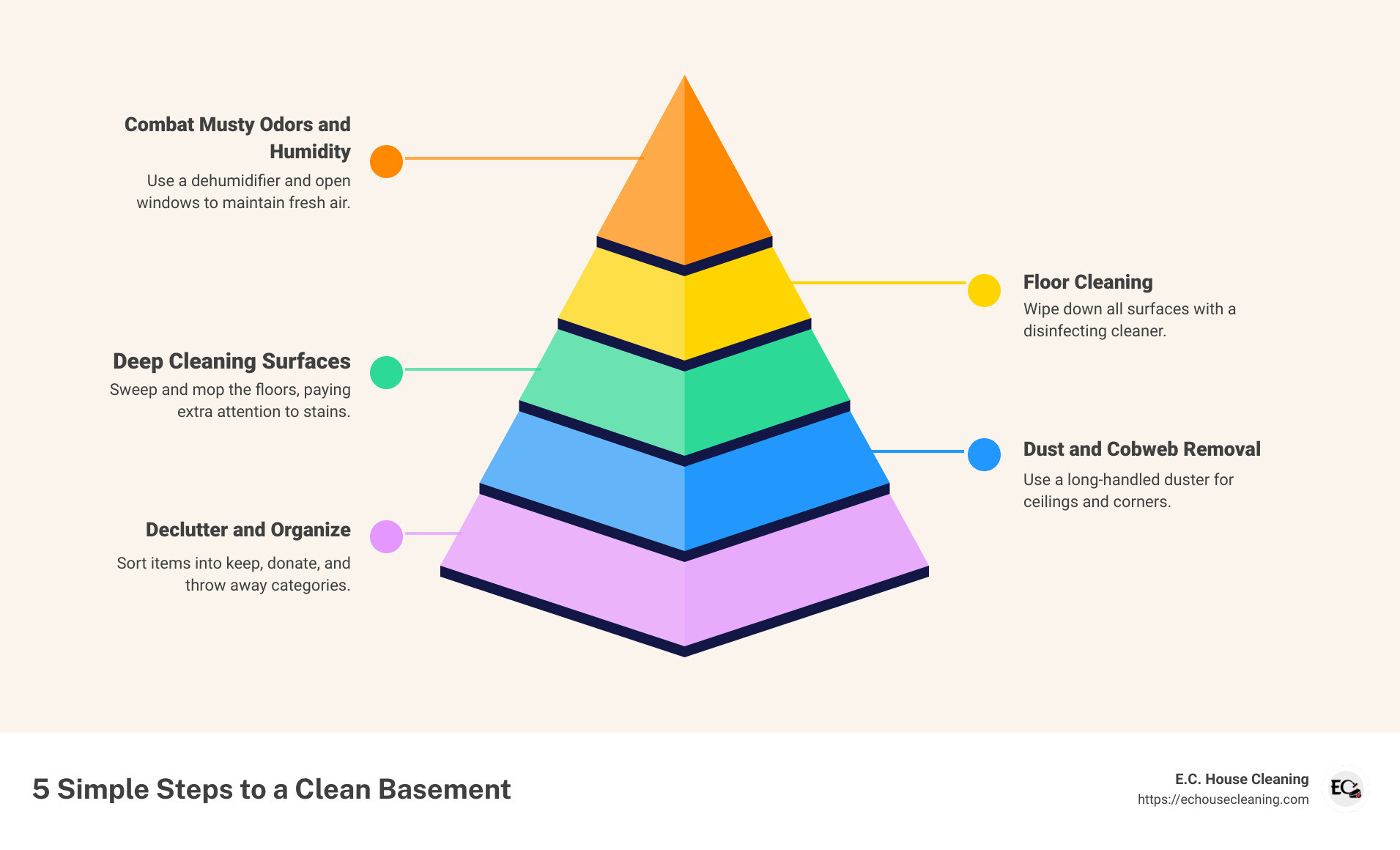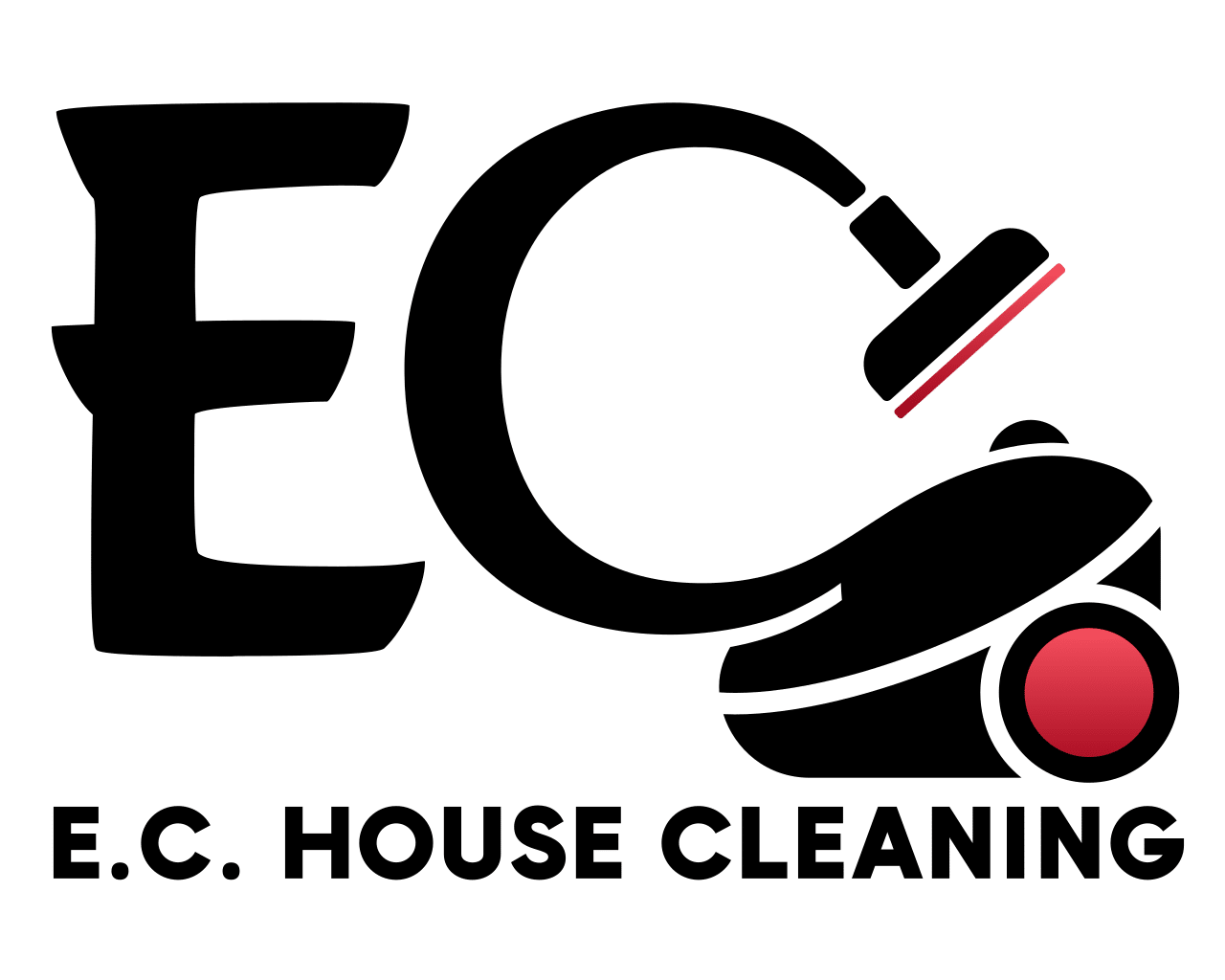Are you staring down a basement that’s more dungeon than delightful? You’re not alone.
Many busy professionals and families find the basement to be the last frontier of home cleanup—a daunting task that often gets pushed to the bottom of the to-do list.
Yet, the benefits of a clean basement go beyond mere aesthetics; it’s about creating a healthier, stress-free living environment for you and your loved ones.
In this guide, “How to Clean Your Basement Fast by Using 5 Simple Steps,” we cut through the clutter and complexity, delivering a straightforward path to reclaiming your basement.
From decluttering strategies to combating humidity, we’ve distilled the essentials into manageable tasks, making it possible to achieve a cleaner, more organized basement without sacrificing your entire weekend.
How to Clean Basement: Basement Cleaning Checklist
- Declutter and Organize: Begin by sorting your loose items into keep, donate, and throw-away categories.
- Dust and Cobweb Removal: Use a long-handled duster for hard-to-reach areas.
- Deep Cleaning Surfaces: Wipe down all surfaces with a damp cloth, using a mild detergent.
- Floor Cleaning: Sweep and mop the floors, focusing on stains or dirty areas.
- Combat Musty Odors and Humidity: Use a dehumidifier and open windows to air out the space.

Whether you’re looking to transform your basement into a functional living space or simply aiming to reduce allergens and improve air quality, this guide is engineered to help you swiftly navigate the cleanup process, with a focus on efficiency and effectiveness.
Table of Contents
Let’s turn that daunting task into a done deal.
Step 1: Declutter and Organize
Transforming your basement starts with decluttering and organizing. A cluttered basement not only looks messy but possibly even pests and dust.
Here’s how we suggest tackling this crucial step to make your decluttering project smoother and more effective.
Sort Through Junk
Begin by sorting through everything in your basement. Create distinct piles or use bins to categorize items into “keep,” “donate,” “recycle,” and “discard.”
Be honest with yourself about the usefulness of each item. If something hasn’t been used in over a year and holds no sentimental value, it might be time to let it go.
Use Donation Centers to Find Homes for Your Items
For items you decide to keep, find appropriate spots in your home or invest in storage solutions.
A donation center can give your unwanted goods a second life, while recycling and properly disposing of items will minimize your environmental impact.
Invest in Storage Unit Solutions
Smart storage solutions are your best friends in keeping your basement organized.
Here is a List of Storage Solutions for Your Basement Cleanout:
- Shelving units, bins, and labels can make a world of difference.
- Shelving allows you to use vertical space efficiently, keeping the floor clear and items available for easy access.
- Choose clear bins when possible, so you can easily see what’s inside, and don’t forget to label each bin and shelf.
This simple step can save you time and frustration when searching for items in the future.
Label Everything
Labeling is key to maintaining an organized basement. Once you’ve sorted your items and placed them in bins or on shelves, clearly label each container.
This not only helps you find things quickly but also aids in keeping the space tidy. When everything has a designated spot, it’s easier to put things back where they belong.
Decluttering areas and organizing your basement items might seem like a daunting task, but it sets the foundation for a cleaner, more functional space.
The goal is to create a basement that serves your needs—whether that’s storage, a workspace, or a living area.
Step 2: Dust and Cobweb Removal

After you’ve decluttered and organized your basement, you’ll likely notice dust and cobwebs that have settled in corners and on surfaces. This step is crucial for maintaining a healthy environment in your basement.
Let’s dive into the simple ways you can tackle dust and cobwebs effectively.
Why House Cleaning of Basement is Important
Dust and cobwebs aren’t just unsightly; they can contribute to poor air quality and aggravate allergies.
Additionally, it helps prevent mold growth, safeguards against pest infestations and addresses safety hazards. Routine Cleaning solutions preserve belongings and prevent water damage.
By regularly removing dirt tucked away in crawl spaces, you ensure your basement remains a comfortable and healthy space for everyone.
Tools You’ll Need
- Long-handled duster: This tool is essential for reaching high corners and ceilings where cobwebs tend to accumulate.
- Microfiber cloths: Ideal for capturing dust without spreading it around.
- Vacuum with a HEPA filter: Ensures that smaller dust particles are trapped and not released back into the air.
The Process of Removing Remaining Dust and Cobwebs
- Start High: Use your long-handled duster to gently remove cobwebs from ceiling corners and along the upper edges of walls. Work your way around the entire basement to ensure no area is missed.
- High-Touch Surfaces: Switch to a microfiber cloth lightly dampened with a disinfecting cleaner. Wipe down high-touch surfaces like doorknobs, light switches, and railings. These areas can collect dust and germs, so giving them attention can significantly improve the cleanliness of your basement.
- Walls and Fixed Structures: Dust tends to settle on less obvious surfaces such as the tops of door frames, window sills, and any shelving units or cabinets. Use your microfiber cloth or a clean, dry duster to wipe these areas down.
- Vacuum Last: Once you’ve dusted all surfaces and removed cobwebs, it’s time to vacuum. Using a vacuum with a HEPA filter is best, especially for carpeted areas. Don’t forget to vacuum the floors, including any hard-to-reach spots you’ve disturbed while dusting.
Tips for Efficiency
- Work in Sections: Divide your basement into sections and clean one area at a time. This method ensures you don’t miss any spots and makes the task feel less overwhelming.
- Regular Maintenance: Dust and cobweb removal should be a regular part of your cleaning routine. The more frequently you do it, the less time it will take each time.
Step 3: Deep Cleaning Surfaces
After taking care of dust and cobwebs, it’s time to dive into deep cleaning the surfaces in your basement. This step is crucial for removing hidden grime, stains, and potential allergens that could compromise the air quality and overall cleanliness of your space.
Using a Shop Vac
Start with a shop vacuum that has a HEPA filter. This is not just any regular vacuum cleaner; it’s a powerful tool designed to tackle heavy-duty cleaning, perfect for basements where dust and debris can be more stubborn. Use it on all surfaces, including floors, walls, and any upholstered furniture.
The HEPA filter ensures that even the smallest particles are captured, leaving your basement air cleaner.
Microfiber Cloths for Dusting and Wiping
Next, arm yourself with microfiber cloths. When it comes to picking up dust, dirt, and grime, these soft cloths are your best friend. They’re designed to trap particles rather than just moving them around.
For surfaces like countertops, shelves, and appliances, dampen a microfiber cloth with water or a mild, eco-friendly cleaning solution.
At E.C. House Cleaning, we emphasize the use of eco-friendly products not only for their effectiveness but also for their safety and minimal environmental impact.
Disinfecting Cleaner for High-Touch Areas
High-touch areas in your basement, such as doorknobs, light switches, and railings, require special attention. Use a disinfecting cleaner approved for use against common pathogens. This ensures that you’re not only cleaning but also sanitizing these surfaces, making your basement a safer environment.
The goal is to reduce the spread of germs, especially in areas that might not get cleaned as frequently.
Air Purifiers: A Supplementary Step
While not everyone may have an air purifier, incorporating one into your basement cleaning routine can significantly improve air quality, especially after a deep clean.
Air purifiers can help remove residual dust particles and odors, making the space more comfortable and healthier to spend time in.
Step 4: Basement Floor Cleaning

Cleaning your basement floor is crucial for removing dirt, grime, and potential allergens. Whether you have concrete floors, carpeted areas, or a mix of both, we have the steps to ensure a thorough clean.
Concrete Floors
- Sweep or Vacuum: Start by removing any loose dirt or debris. A shop vacuum is ideal for this, but a regular broom will also do the job.
- Mop with the Right Cleaner: Use a mop and a cleaner that’s recommended for concrete. You can find this information on the cleaner’s label. If you’re unsure, a mix of mild detergent and water is a safe bet. Here’s a guide on how to clean concrete floors to help you.
- Rinse Well: After mopping, it’s important to rinse the floor with clean water to remove any leftover soap residue.
- Dry the Floor: Use fans or open windows to air dry the floor. Moisture can lead to mold, so ensure the floor is completely dry.
Carpeted Areas
- Vacuum: Use a HEPA filter vacuum to remove dust, dirt, and potential allergens from the carpet. Make sure to vacuum corners and edges where dirt accumulates.
- Spot Clean Stains: Use a carpet cleaner to treat any spots or stains. Follow the instructions on the cleaner for the best results.
- Deep Clean: Consider renting a carpet cleaner or hiring a professional service for a deep clean, especially if the carpet hasn’t been cleaned in a while.
General Tips
- Stiff Nylon Brush: For stubborn stains or grime on concrete floors, use a stiff nylon brush with your cleaning solution to scrub the area before mopping.
- Dry Thoroughly: Whether you’re dealing with concrete or carpet, ensure the area is completely dry to prevent mold and mildew growth.
- Regular Maintenance: Regularly clean your basement floors to keep them in good condition and prevent the buildup of dirt and grime.
At E.C. House Cleaning, we understand that your time is valuable. That’s why we’re here to offer our expert cleaning services, tailored to your needs. Whether you’re tackling a basement cleaning project yourself or looking for professional help, we’re committed to helping you achieve a clean, healthy home.
Step 5: Combat Musty Odors and Humidity
Basements can often become damp, leading to musty odors and high humidity levels. This not only affects the air quality but can also contribute to mold growth.
Here’s how to tackle these issues effectively:
Use a Dehumidifier
A dehumidifier is your best friend when it comes to reducing humidity in your basement. It works by pulling moisture from the air, helping to prevent mold and mildew. For best results, aim to keep the humidity level below 60%.
Open Windows
Whenever weather permits, open windows to allow fresh air to circulate. This helps to flush out stale, musty air and reduces humidity levels. Even a few minutes a day can make a significant difference.
Use Fans
Fans can also help improve air circulation. If you have windows in your basement, place a fan near one to help draw fresh air in and push damp air out. This is especially useful during dry, sunny days.
Odor-Busting Tips
- Baking Soda: It’s not just for baking! Sprinkle baking soda on carpets or floors, let it sit for a while to absorb odors, then vacuum it up.
- Charcoal: Activated charcoal can absorb odors and moisture. Place bowls of charcoal around the basement to help keep it fresh.
- Vinegar: Set out bowls of vinegar to help neutralize odors. Don’t worry, the vinegar smell will dissipate, taking other odors with it.
At E.C. House Cleaning, we prioritize your health and comfort by using eco-friendly and pet-friendly cleaning products. Not only do we aim to leave your space sparkling clean, but we also ensure it’s safe for everyone in your household.
Tackling musty odors and humidity isn’t just about making your basement smell better; it’s about creating a healthier environment for your family.
By following these steps, you can enjoy a fresher, drier basement that’s more pleasant to spend time in.
Conclusion
Cleaning your basement might seem like a big, time-consuming task. Yet, breaking down a basement cleanout into five easy steps can make it much simpler.
Maintaining a clean basement is crucial for your home’s overall health and your family’s well-being. A clean basement reduces the risk of mold and mildew, which can affect air quality and lead to health issues.
Contact us at E.C. House Cleaning to get started on your next basement cleaning, we’re committed to providing you with eco-friendly basement cleaning solutions. Our goal is to help you maintain a clean, healthy, and comfortable home environment, starting with the often-overlooked areas like your basement.
However, if you find the eco-friendly basement cleaning project overwhelming or simply don’t have the time, E.C. House Cleaning is here to help. We provide expert cleaning services to ensure your basement—and your entire home—is a clean, healthy place for you and your family.
For further reading and more tips on keeping your basement spotless, check out our guides on bi-weekly house cleaning and finding no-judgment house cleaning services. Let us help you maintain a clean and healthy home environment with our professional cleaning services.
Frequently Asked Questions about Basement Cleaning
When it comes to keeping your basement clean and healthy, you might have a few questions. We’ve compiled the most common ones we hear from our clients to help guide you through the process.
How often should the basement be cleaned?
The frequency of basement cleaning largely depends on how you use the space.
- If it’s an active part of your home, we recommend giving it a thorough cleaning once a month.
- For less frequently used basements, a deep clean every few months should suffice.
However, it’s always a good idea to do a quick sweep for cobwebs and dust bunnies in between deep cleanings to keep things manageable.
Should you clean an unfinished basement?
Absolutely. Even though it might not be a living space, an unfinished basement can still collect dust, develop cobwebs, and even suffer from moisture issues.
Cleaning it twice a year can help you spot any potential problems, like leaks or cracks within the drainage pipe, early on.
During these cleanings, focus on removing dust and cobwebs, making sure that you check for any signs of moisture or damage. It’s not just about cleanliness; it’s also about maintaining the structural integrity of your home.
How do you clean a really dirty basement?
For those basements that have seen better days, here’s a straightforward approach to tackling a messy basement:
- Sort through your junk. Before anything else, decide what stays and what goes. Items that haven’t been used in years and don’t hold sentimental value should be donated or tossed.
- Get organized. Use shelves, bins, and labels to keep everything in its place. This not only helps during the cleaning process but also makes it easier to find things later on.
- Dust the hard-to-reach areas. Use a long-handled duster to get rid of cobwebs and dust in ceiling corners and other difficult spots.
- Vacuum. A high-quality shop vacuum can handle both dry and wet messes, making it perfect for basement cleaning. Don’t forget to vacuum the floors thoroughly.
- Mop the floor. For concrete floors, use a mix of water and mild detergent. If you have carpet, consider renting a steam cleaner to refresh the fibers.
- Combat the musty smell. Use a dehumidifier to manage humidity levels and open windows to air out the space, weather permitting. Baking soda can also help absorb odors.
Whether you’re dealing with a slightly untidy basement or a space that hasn’t been cleaned in years, breaking the process down into manageable steps can make the task less daunting.
Our Content
All content is written by E.C. House Cleaning’s professional cleaning company. We put our expertise in house cleaning services into each piece of content, focusing on providing valuable, accurate, and relevant information.
With over 20 years of deep, full cleaning service industry experience in the Massachusetts and Boston area with a proven track record of pet-friendly cleaning in Massachusetts, residential deep cleaning, cleaning of light fixtures, house cleaning of the basement, eco-friendly cleaning of cluttered areas, Eco-friendly Basement Cleaning in Massachusetts, and trust for customers as signaled by our hundreds of 5-star reviews, E.C. House Cleaning is an authority on residential and commercial cleaning services.
